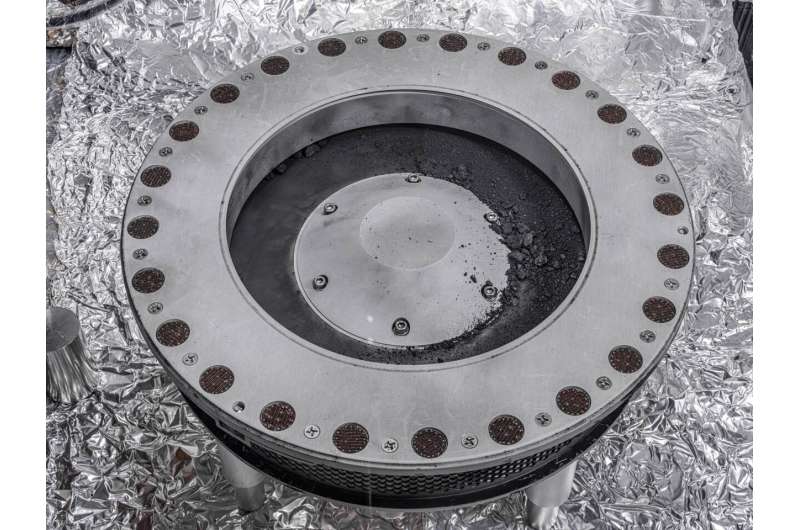This article has been reviewed according to Science X's editorial process and policies. Editors have highlighted the following attributes while ensuring the content's credibility:
fact-checked
trusted source
proofread
NASA's OSIRIS-REx mission surpasses goal for collection of asteroid samples

The curation team processing NASA's asteroid Bennu sample has removed and collected 2.48 ounces (70.3 grams) of rocks and dust from the sampler hardware—surpassing the agency's goal of bringing at least 60 grams to Earth.
And the good news is, there's still more of NASA's OSIRIS-REx (Origins, Spectral Interpretation, Resource Identification, and Security–Regolith Explorer) sample to collect.
The sample processed so far includes the rocks and dust found on the outside of the sampler head, as well as a portion of the bulk sample from inside the head, which was accessed through the head's mylar flap. Additional material remaining inside the sampler head, called the Touch-and-Go Sample Acquisition Mechanism, or TAGSAM, is set for removal later, adding to the mass total.
In the last week, the team at NASA's Johnson Space Center in Houston changed its approach to opening the TAGSAM head, which contained the bulk of the rocks and dust collected by the spacecraft in 2020. After multiple attempts at removal, the team discovered two of the 35 fasteners on the TAGSAM head could not be removed with the current tools approved for use in the OSIRIS-REx glovebox. The team has been working to develop and implement new approaches to extract the material inside the head, while continuing to keep the sample safe and pristine.
As a first step, the team successfully accessed some of the material by holding down the head's mylar flap and removing the sample inside with tweezers or a scoop, depending on material size. The collection and containment of material through this method, combined with the earlier collection of material located outside the head, yielded a total mass exceeding the 60 grams required.
The team will spend the next few weeks developing and practicing a new procedure to remove the remaining asteroid sample from the TAGSAM sampler head while simultaneously processing the material that was collected this week. The OSIRIS-REx science team will also proceed with its plan to characterize the extracted material and begin analysis of the bulk sample obtained so far.
All curation work on the sample—and the TAGSAM head—is performed in a specialized glovebox under a flow of nitrogen to keep it from being exposed to Earth's atmosphere, preserving the sample's pristine state for subsequent scientific analysis. The tools for any proposed solution to extract the remaining material from the head must be able to fit inside the glovebox and not compromise the scientific integrity of the collection, and any procedures must be consistent with the clean room's standards.
While the procedure to access the final portion of the material is being developed, the team has removed the TAGSAM head from the active flow of nitrogen in the glovebox and stored it in its transfer container, sealed with an O-ring and surrounded by a sealed Teflon bag to make sure the sample is kept safe in a stable, nitrogen-rich, environment.
Provided by NASA




















